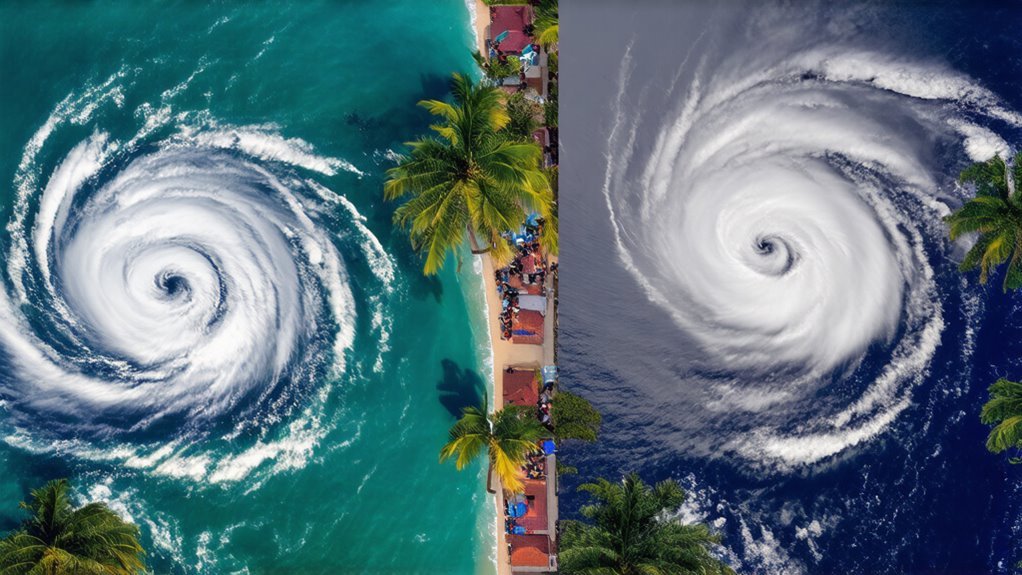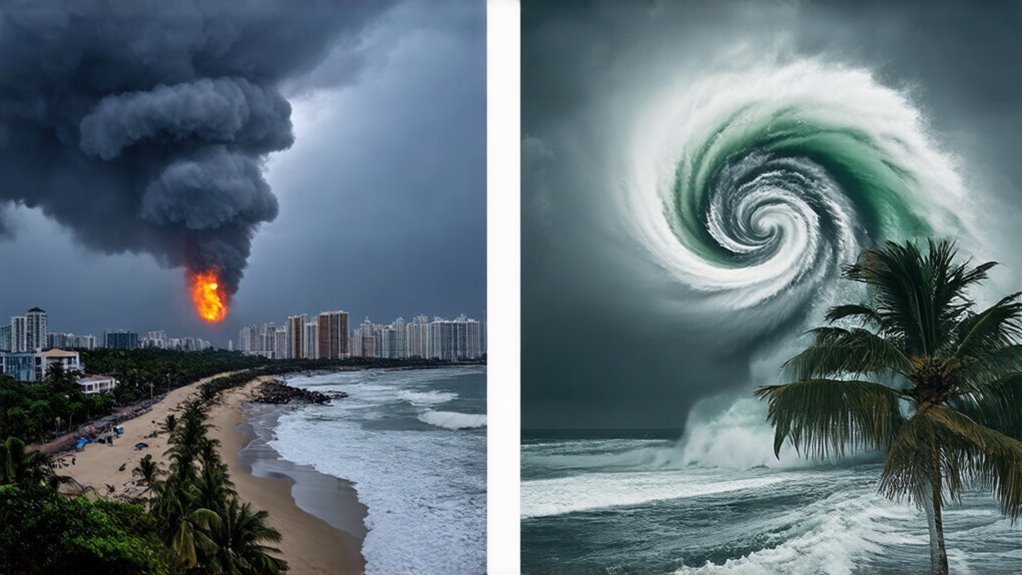I’ve always been fascinated by massive storms, but I’ll admit I used to think hurricanes and typhoons were completely different phenomena. They’re actually the same type of storm with different names based on geography. When I hear weather reports about a typhoon hitting Japan or a hurricane approaching Florida, I’m reminded that our naming conventions often mask scientific similarities. The distinction seems arbitrary, but there’s more to the story than just terminology.
Same Storm, Different Names: Understanding Regional Terminology

While we often use the terms “hurricane” and “typhoon” interchangeably in casual conversation, they’re actually the same weather phenomenon called by different names depending on where they occur.
I’ve always found these regional variations fascinating. In the Atlantic and eastern Pacific, we call them hurricanes, while in the western Pacific, they’re typhoons. The terminology evolution stems from historical and cultural differences across regions, not from any scientific distinction in the storms themselves.
Nature’s fury bears different names across our oceans, though the winds howl with equal strength no matter what we call them.
It’s a bit like how I might say “apartment” while my British friend says “flat” – same thing, different words.
Perhaps understanding these naming conventions helps us appreciate our connected global weather systems.
The Science Behind Tropical Cyclone Formation

Speaking of the storms themselves, let’s look at what actually creates these powerful weather systems.
Tropical cyclone mechanics are fascinating, yet complex. They require a perfect storm of conditions—literally.
For a hurricane or typhoon to form, we need warm ocean water (I think above 80°F), unstable atmospheric conditions, and an existing weather disturbance. It’s like nature’s recipe for chaos. The warm water evaporates, creates energy, and when wind patterns align just right, they start spinning.
Perhaps what’s most interesting is how these factors must persist.
Without continuous fuel from warm waters, the cyclone weakens and dissipates.
Comparing Hurricane and Typhoon Intensity Scales

Although hurricanes and typhoons are fundamentally the same weather phenomenon, they’re measured using different intensity scales depending on where they occur.
In the Atlantic and Eastern Pacific, I use the Saffir-Simpson scale, which categorizes hurricanes from 1-5 based on wind speed. Category 5 means winds over 157 mph – pretty terrifying, I think.
For typhoons in the Western Pacific, they’re measured on the Japan Meteorological Agency scale, which extends further for intensity measurement.
This scale comparison reveals that some regions recognize “super typhoons” when winds exceed 150 mph, while we don’t have an equivalent category for hurricanes.
Perhaps that’s why typhoons sometimes sound more intimidating!
Geographic Distribution of Tropical Cyclones Worldwide

Seven distinct regions across our planet serve as birthplaces for tropical cyclones, making their distribution far from random.
I’ve always found tropical cyclone geography fascinating because it reveals so much about our Earth’s climate systems. The Northwest Pacific basin generates the most storms annually, I think around 25-30 on average.
Tropical cyclone patterns showcase nature’s organized chaos, with the Northwest Pacific serving as our planet’s most prolific storm factory.
Meanwhile, the North Atlantic (where we get hurricanes) typically sees far fewer. The South Pacific, Indian Ocean, and Australia’s waters round out our global storm distribution map.
What’s perhaps most interesting is how rarely these storms cross the equator – it’s a natural boundary they seldom breach.
Seasonal Patterns: When These Storms Typically Strike

While hurricanes and typhoons can technically form at any time, they follow distinct seasonal patterns that I’ve tracked over the years.
The Atlantic hurricane season officially runs June through November, with peak activity around September. I think the Pacific storm timing varies, with typhoons occurring year-round but peaking in late summer.
- Atlantic basin storms rarely form outside their designated season, though climate change might be shifting these seasonal trends.
- Western Pacific typhoons can develop in any month, but are perhaps most common July-October.
- Southern hemisphere cyclones typically strike between November-April, opposite to northern regions.
The predictability of these patterns helps communities prepare, though I’ve noticed exceptions occasionally occur.
Notable Historical Hurricanes and Typhoons Compared
The seasonal patterns we’ve just explored have given us a framework for understanding when these massive storms occur, but examining specific historical examples helps put their destructive power into perspective.
I think it’s impossible to discuss famous storms without mentioning Hurricane Katrina (2005), which devastated New Orleans with catastrophic flooding, or Typhoon Haiyan (2013) that ravaged the Philippines with unprecedented wind speeds.
The historical impacts of these events extend beyond physical damage – they’ve changed how we approach disaster preparedness.
Perhaps what’s most striking is how both hurricanes and typhoons, despite their different names, have left eerily similar patterns of destruction across continents.
Impact Assessment: How These Storms Affect Different Regions
Despite similar meteorological characteristics, hurricanes and typhoons impact regions across the globe in vastly different ways, shaped by local infrastructure, geography, and preparedness systems.
I’ve noticed that regional resilience varies dramatically between coastal areas in the Philippines versus Florida, perhaps due to economic factors.
- Caribbean nations often face catastrophic infrastructure damage from hurricanes, with recovery times extending years.
- Pacific island communities have developed traditional warning systems for typhoons that complement modern forecasting.
- Coastal megacities in Asia experience different storm impacts than rural areas in the American South.
I think understanding these regional differences is essential for improving global response strategies to these devastating storms.
Preparedness Strategies for Both Storm Types
These regional differences in storm impacts lead me to wonder about preparedness—what strategies work best regardless of whether you’re facing a hurricane or typhoon?
I’ve found that emergency kits are absolutely essential. They should include water, non-perishable food, medications, and important documents.
Perhaps the most overlooked item is cash—electronic payments often fail during major storms.
In the chaos following severe storms, cash becomes king when power outages render credit cards and digital wallets useless.
Evacuation plans need to be established well before any warnings. I think many people wait too long, hoping the storm will change course.
Frequently Asked Questions
Can Hurricane-Typhoon Transitions Occur During a Single Storm?
Like dancers changing costumes, yes, I can confirm that storms can switch between hurricane and typhoon classification based solely on their location as they cross different ocean weather patterns.
How Do Climate Change Trends Affect Tropical Cyclone Development?
I’ve observed that changing climate patterns are increasing cyclone intensity by warming oceans and altering wind systems, creating more powerful storms that develop faster and last longer.
What Technologies Are Used to Predict Hurricane and Typhoon Paths?
Coincidentally, I was just studying this! I rely on satellite imagery to track storm formations and advanced weather modeling algorithms to predict where hurricanes and typhoons will travel next.
Do Tropical Cyclones Help Regulate Earth’s Heat Distribution?
Yes, I believe tropical cyclones do impact Earth’s heat distribution, transferring warmth from tropical oceans to cooler regions through their massive energy transport systems. They’re natural climate regulators.
How Long Does It Take for an Area to Recover?
I find full recovery from tropical cyclones fundamentally varies, typically taking months to decades. Recovery time depends on damage extent, while rebuilding efforts reflect community resources and outside assistance available.